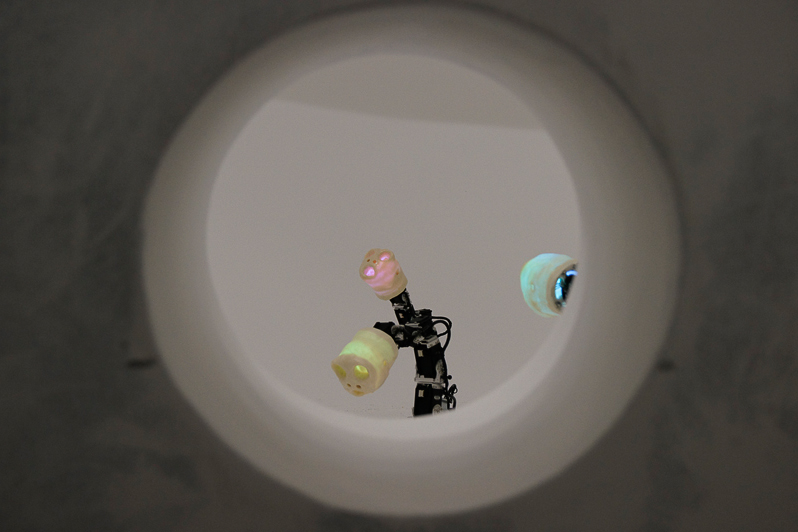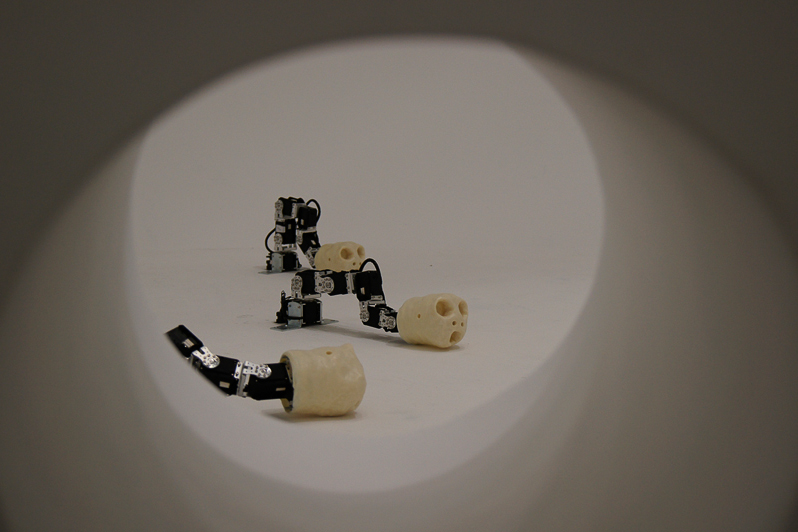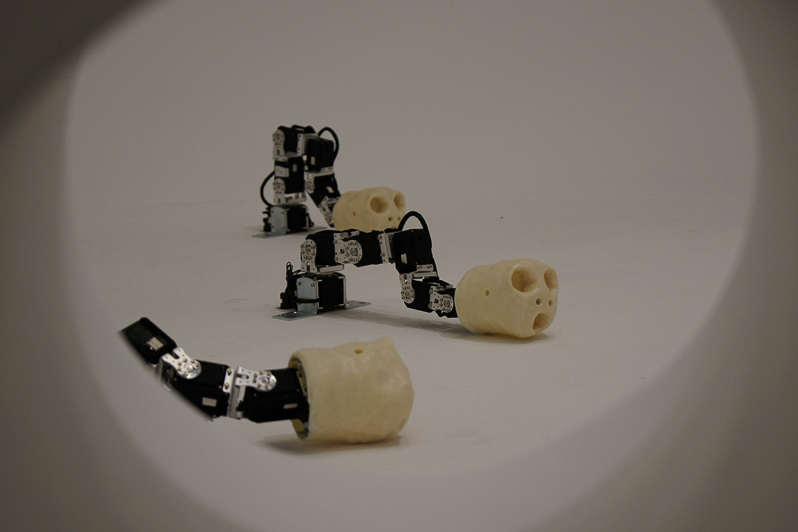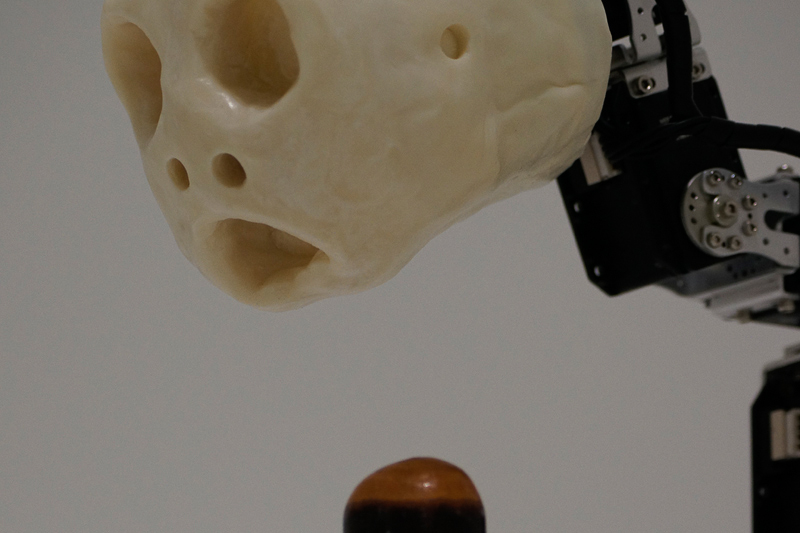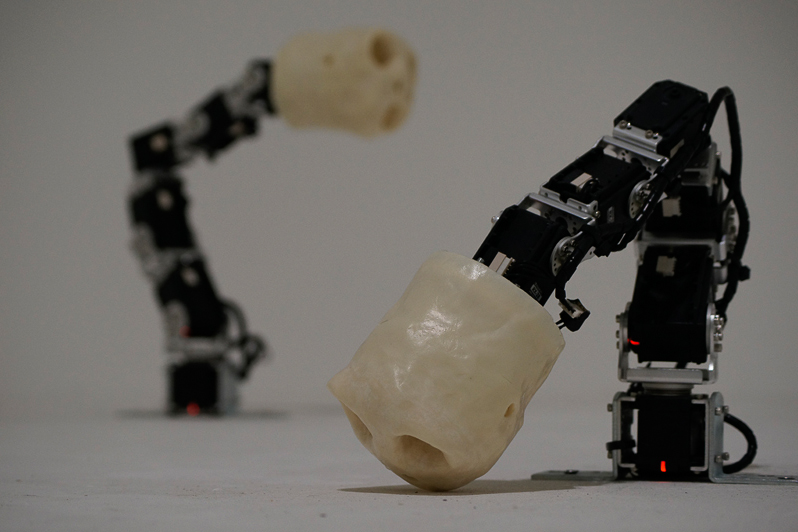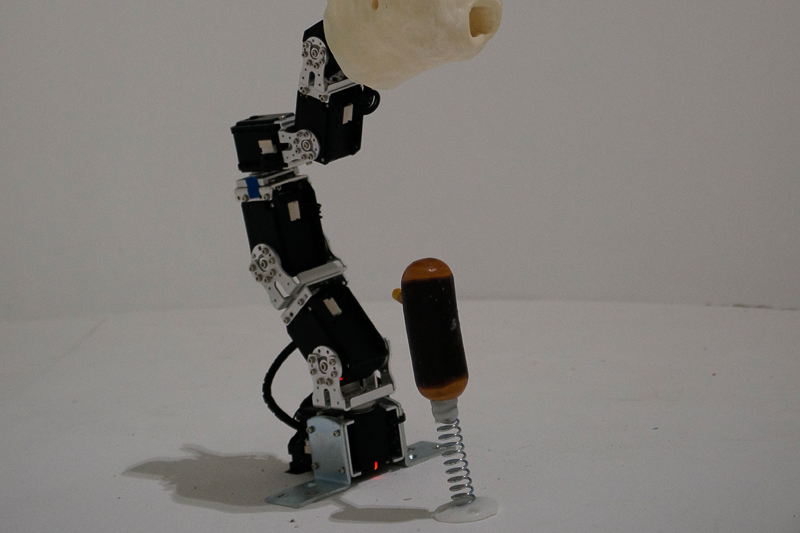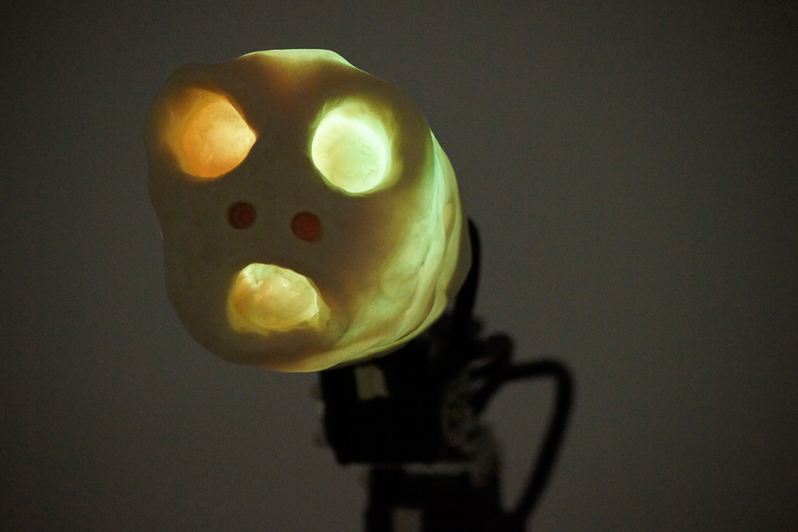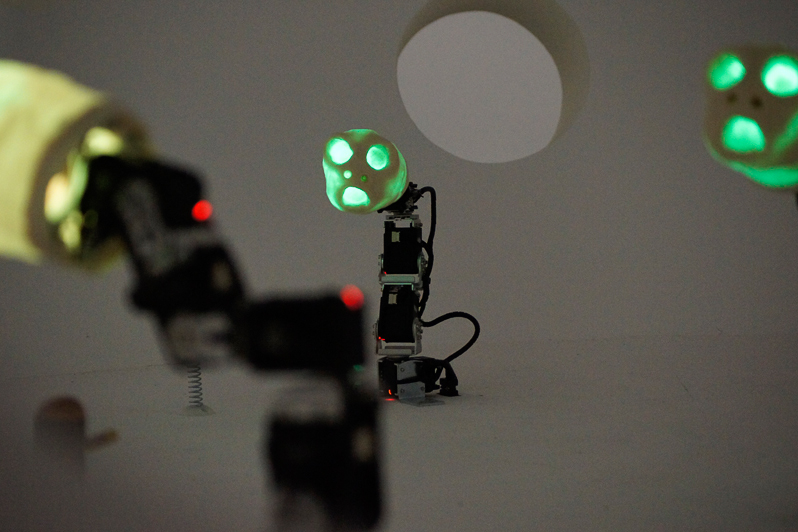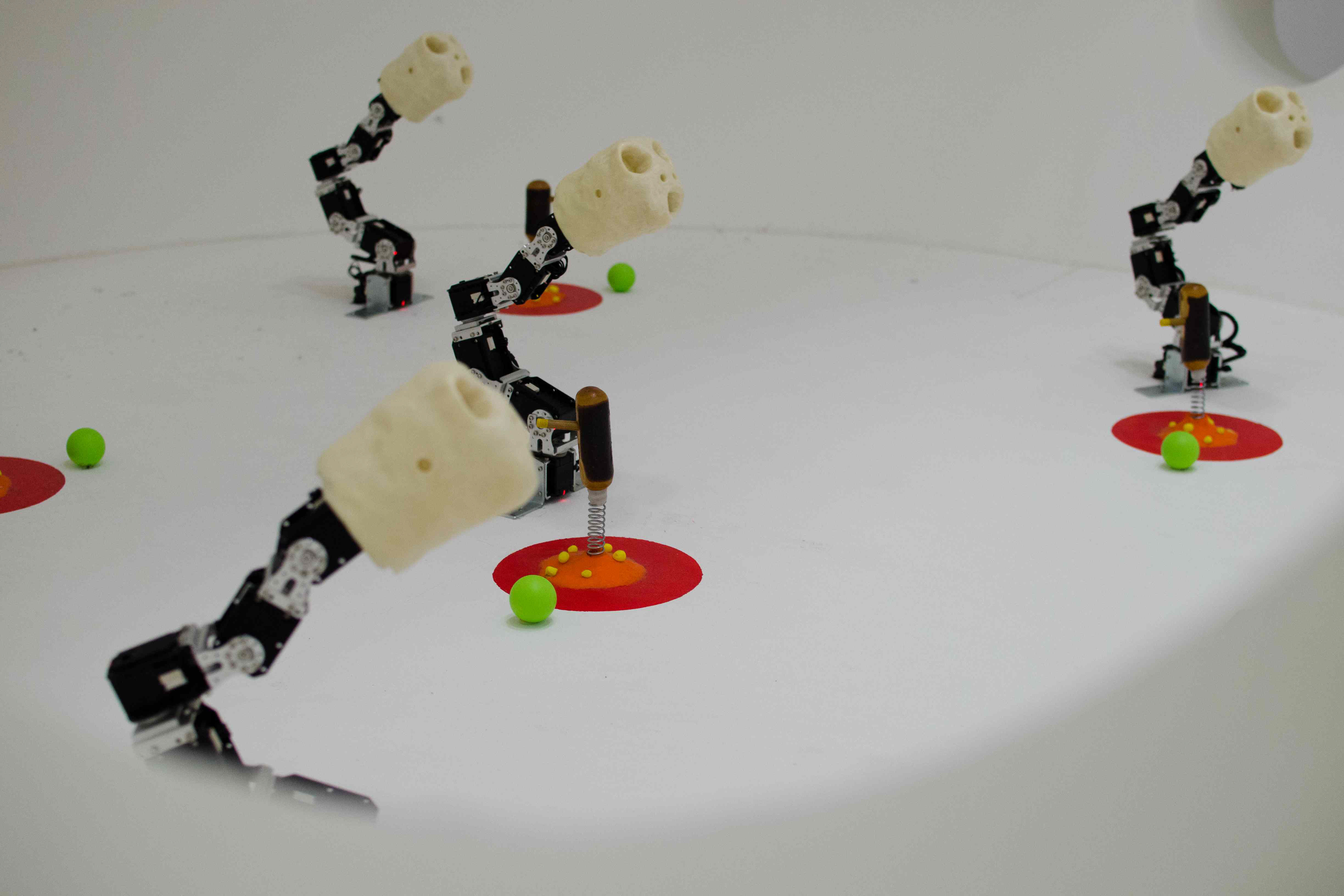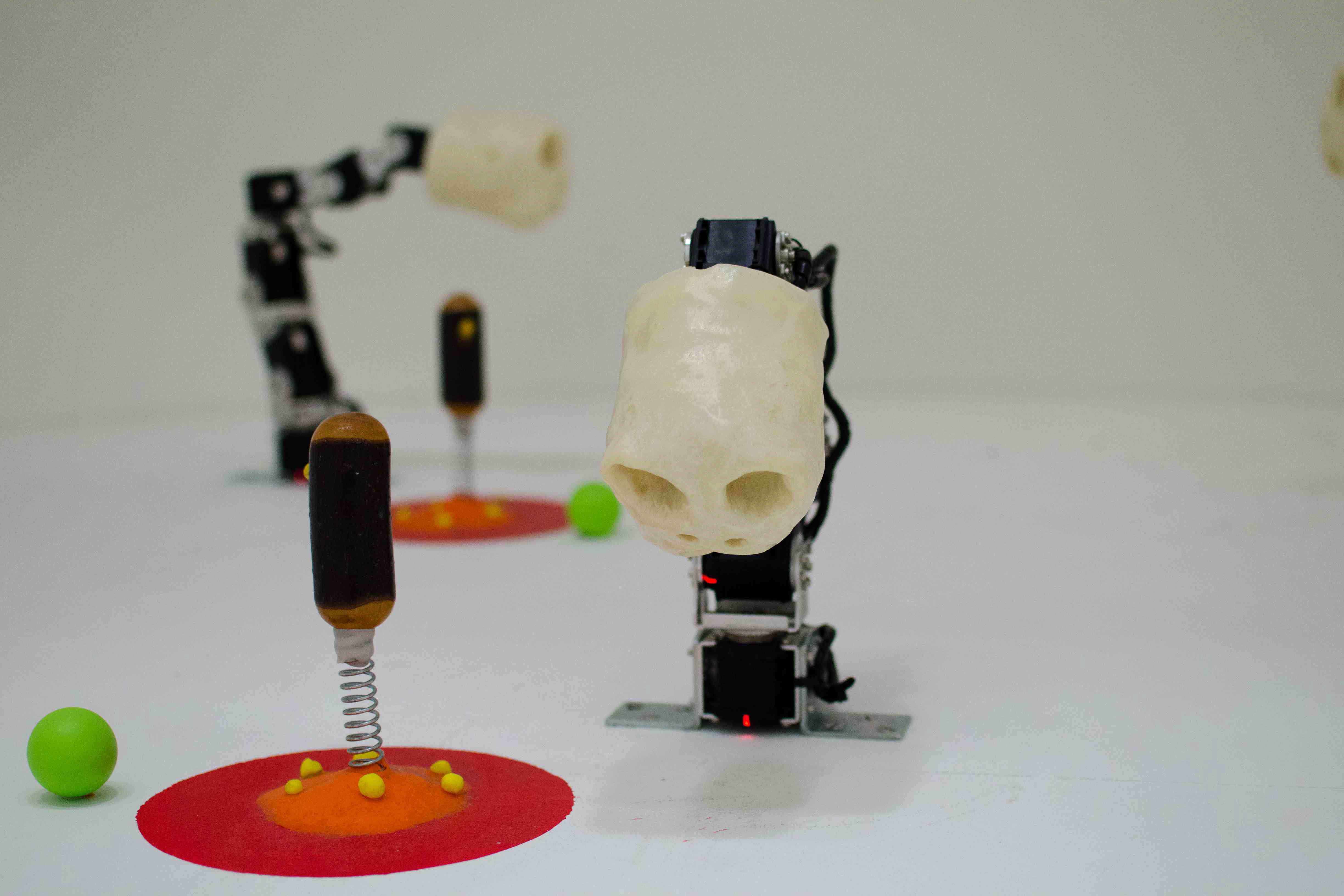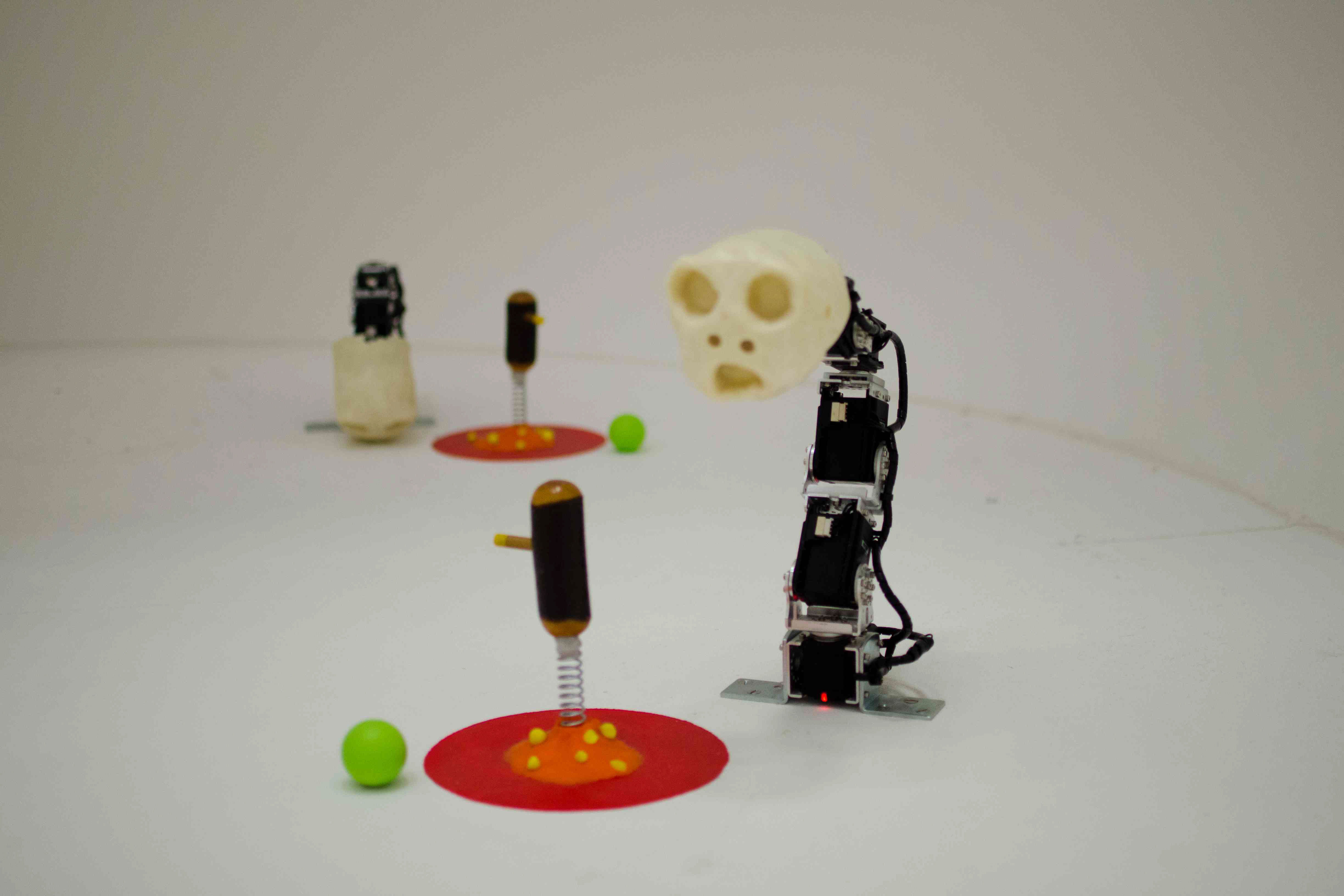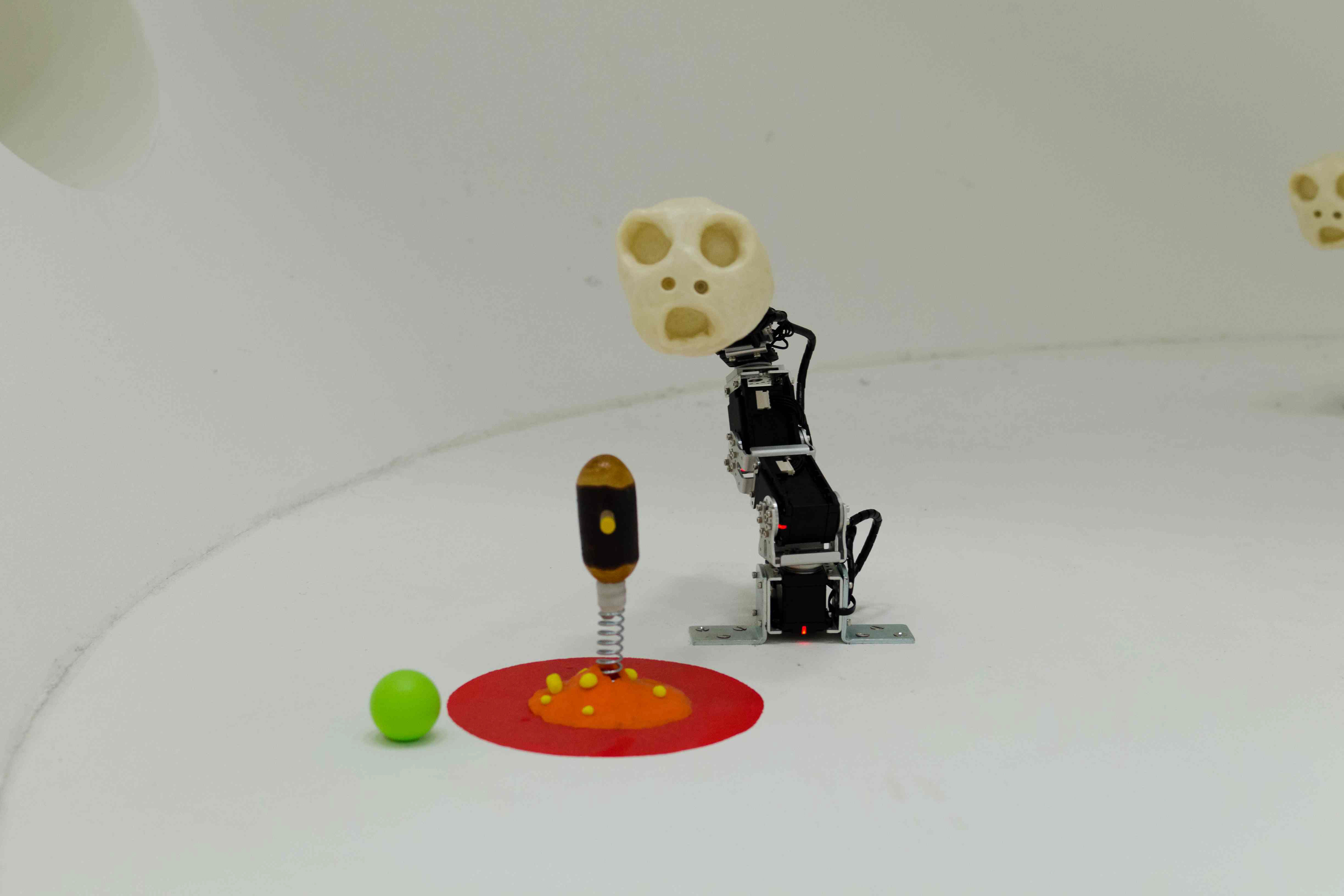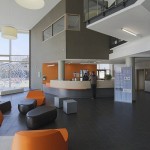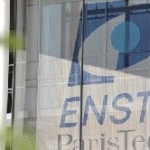Flowers Laboratory
FLOWing Epigenetic Robots and Systems
Ergo-Robots
The Ergo-Robots Experiment
Artificial curiosity and language formation in robots
Exhibition “Mathematics: A Beautiful Elsewhere”
Fondation Cartier pour l’Art Contemporain
Direct links: Exhibition – Team – Publications – Videos – Photos – Press
In a big egg that has just opened, a tribe of young robotic creatures evolves and explores its environment, wreathed by a large zero that symbolizes the “origin.” Beyond their innate capabilities, they are outfitted with mechanisms that allow them to learn new skills and invent their own language. Endowed with artificial curiosity, they explore objects around them, as well as the effect their vocalizations produce on humans. Human, also curious to see what these creatures can do, react with their own gestures, creating a loop of interaction which progressively self-organizes into a new communication system established between man and ergo-robots.
“Ergo-Robots: Artificial Curiosity and Language” is an installation and experiment presented in the exhibition “Mathematics: A Beautiful Elsewhere“, from 21st october 2011 to 18th march 2012, in Fondation Cartier pour l’Art Contemporain, Paris, France.
It features and experiments computational of models of curiosity-driven learning and its interaction with language formation in humans and robots developped by Pierre-Yves Oudeyer and his INRIA ENSTA ParisTech team, as well as earlier models developped with Frédéric Kaplan and by Luc Steels.
At the frontiers of sciences and art, exploring fundamental questions about the nature of humans and machines, it features robots that explore and learn about their environment through artificial curiosity, and at the same time invent their own language, to talk about their environment. Based onrecent advanced models of autonomous learning inspired by human infant development, they progressively acquire new skills, discover ways to communicate with humans, and self-organize their own culture.
The Ergo-Robot Experiment: Artificial Curiosity and Language Formation in Robots Read more...
Presentation of the Ergo-Robot Experiment by Pierre-Yves Oudeyer, during “Symposium on Language Acquisition and Language Evolution”, Stockholm University, Royal Academy of Sciences, Stockholm, Sweden (organised by Francesco Lacerda and Bjorn Lindblom).
=== Main references
Web site: https://flowers.inria.fr/robots/ergo-robots/
Oudeyer, P-Y. (2011) Curiosity and Languages, in Catalogue of the Exhibition “Mathematics: A Beautiful Elsewhere”, Fondation Cartier pour l’Art Contemporain, Paris, France.
https://flowers.inria.fr/OudeyerCatalogueExpoMathematics2011GB.pdf
Oudeyer P-Y, Kaplan , F. and Hafner, V. (2007) Intrinsic Motivation Systems for Autonomous Mental Development, IEEE Transactions on Evolutionary Computation, 11(2), pp. 265–286.
http://www.pyoudeyer.com/ims.pdf
Steels, L. (2003) Evolving grounded communication for robots. Trends in Cognitive Science. 7(7), July 2003, pp. 308-312.
http://www.csl.sony.fr/downloads/papers/2003/steels-03c.pdf
Gottlieb, J., Oudeyer, P-Y., Lopes, M., Baranes, A. (2013)
Trends in Cognitive Science, 17(11), pp. 585-596. http://dx.doi.org/10.1016/j.tics.2013.09.001
The exhibition “Mathematics: A Beautiful Elsewhere”
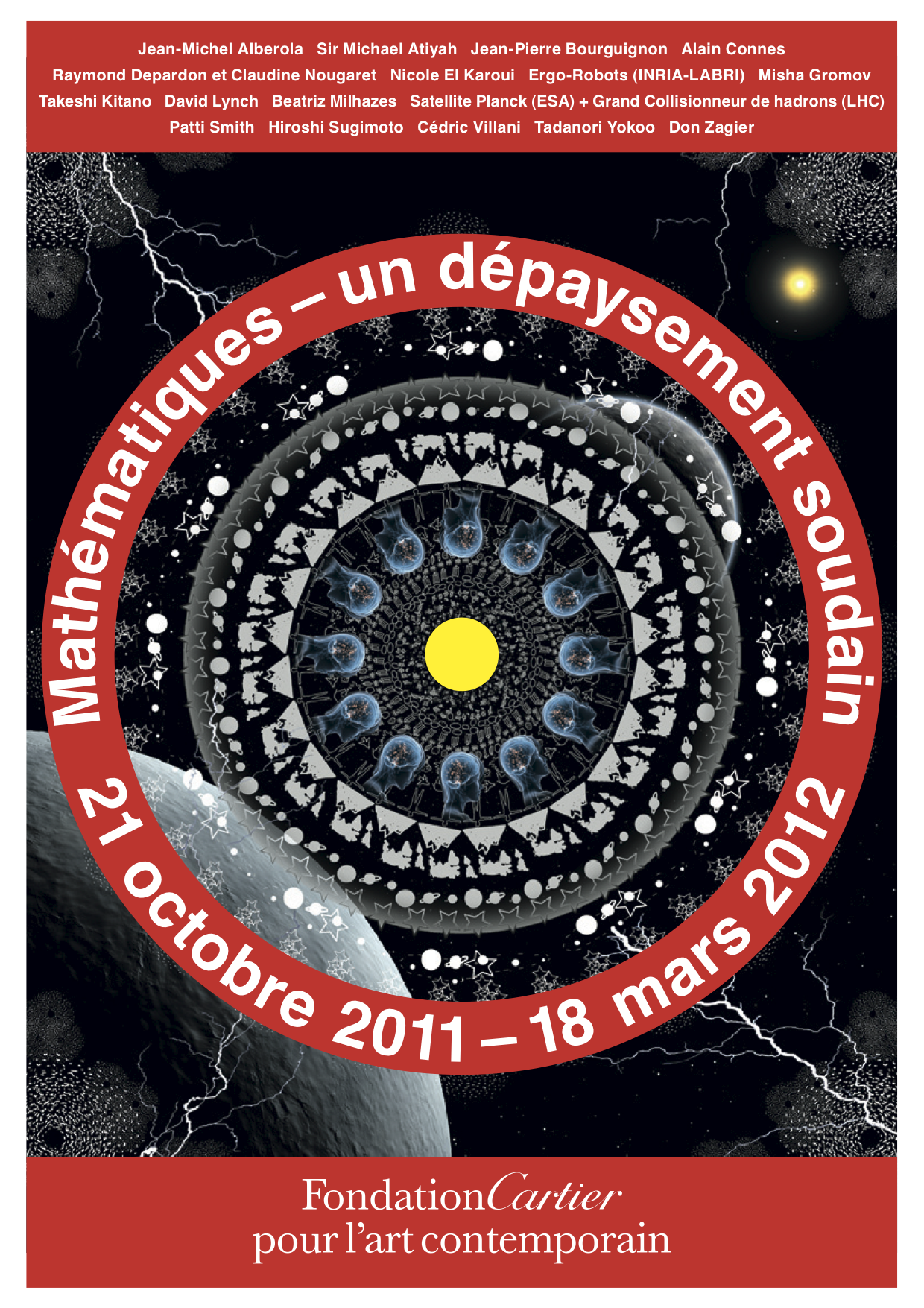
From October 21, 2011 to March 18, 2012, the Fondation Cartier pour l’art contemporain presents the exhibition “Mathematics: A Beautiful Elsewhere“, an exhibition developed in association with the Institut des Hautes Études Scientifiques (IHÉS) and under the patronage of UNESCO. Aiming to create opportunities for seeing, hearing, doing, thinking and interpreting mathematics, Michel Cassé, an astrophysicist, and Hervé Chandès, general director of the Fondation Cartier, guided by the mathematician Jean-Pierre Bourguignon who heads the Institut des Hautes Études Scientifiques, conferred with prestigious mathematicians and scientists. The intellectual universe of mathematicians Sir Michael Atiyah, Alain Connes, Nicole EL Karoui, Misha Gromov, Cédric Villani and Don Zagier, is presented in interaction with artists Jean-Michel Alberola, Raymond Depardon, Claudine Nougaret, Takeshi Kitano, David Lynch, Beatriz Milhazes, Patti Smith, and Hiroshi Sugimoto. By bringing mathematics into its premises, the Fondation Cartier is itself undergoing the “sudden change of scenery” described by the mathematician Alexandre Grothendieck.
The installation Ergo-Robots / Flowers Fields appears in the space dedicated to Misha Gromov, and explores what he calls one of the “four great mysteries”: the origins of intelligence.
Team
Ergo-Robots is a project initiated and conceptualized by Pierre-Yves Oudeyer through an encounter with mathematician Mikhail Gromov (and his theory of ergo-systems), and benefited from a collaboration with artist David Lynch (who designed the head and the environment of the robots).
Its software and hardware development was realized by the INRIA ENSTA ParisTech Flowers team in collaboration with University of Bordeaux/Labri: Jérome Béchu, Fabien Bénureau, Haylee Fogg, Paul Fudal, Hugo Gimbert, Matthieu Lapeyre, Olivier Ly, Olivier Mangin, Pierre-Yves Oudeyer, Pierre Rouanet. Scenography was realized in collaboration with David Lynch and his team. Scenography was realiszed in collaboration with David Lynch and his team.
The Ergo-Robots hardware and software platform builds on a previous experimental set-up called “Flowers Fields”, designed to explore novel forms of human-robot interaction and realized in 2009 by Jérome Béchu and Pierre-Yves Oudeyer, followed by a second version realized with Olivier Ly et Fabien Bénureau.
Contact: pierre-yves.oudeyer _ @ _ inria.fr
Links
Photos of the installation Ergo-Robots available in high-resolution here.
Press release of the exhibition here.
Excerpt from the catalog of the exhibition explaining the scientifc, conceptual and societal context of the installation/scientific experiment Ergo-Robots/Flowers Fields:
Oudeyer, P-Y. (2011) Curiosity and Languages, in Catalogue of the Exhibition “Mathematics: A Beautiful Elsewhere”, Fondation Cartier pour l’Art Contemporain, Paris, France.
Description of the scientific works on which this installation is built: autonomous learning and artificial curiosity in developmental robotics, models of language acquisition and evolution, and interaction between curiosity and the discovery of language.
Publications
The following publications present the epistemology, concepts and techniques on which the Ergo-Robots/Flowers Fields were built:
Oudeyer, P-Y. (2011) Developmental Robotics, Encyclopedia of the Sciences of Learning, N.M. Seel ed., Springer Reference Series, Springer.
Oudeyer, P-Y. (2010) On the impact of robotics in behavioral and cognitive sciences: from insect navigation to human cognitive development, IEEE Transactions on Autonomous Mental Development, 2(1), pp. 2–16.
Oudeyer P-Y, Kaplan , F. and Hafner, V. (2007) Intrinsic Motivation Systems for Autonomous Mental Development, IEEE Transactions on Evolutionary Computation, 11(2), pp. 265–286.
Oudeyer P-Y., Kaplan F. (2006) Discovering Communication, Connection Science, 18(2), pp. 189–206.
Related Publications
The following publications are direclty related to some aspects of the Ergo-Robots/Flowers Fields Experiment:
On ergosystems and curiosity:
Gromov, M. (unpublished, 2011) Structures, Learning and Ergosystems: Chapters.
On models of language evolution:
Steels, L. (2003) Evolving grounded communication for robots. Trends in Cognitive Science. 7(7), July 2003, pp. 308-312.
Acknowledgements
Maintainance and technical support of Ergo-Robots is benefitting from the help of David Filliat and the Cognitive Robotics group at ENSTA, and especially Emmanuel Battesti, Guillaume Duceux, Alexander Gepperth, Natalia Lyubova. We are extremely grateful to them.
The Ergo-Robots shows the result of research partillly funded by ERC Starting Grant EXPLORERS 240007.
Press
In English:
New Scientist, jan. 2012: “Curious skull-bots interact with their human visitors“.
Financial Times, oct. 2011, “Twin Peaks of Maths and Arts“.
The Times, oct. 2011, “Maths and art? Go figure“.
The Saturday Telegraph, oct. 2011, “Art plus maths: do they add up?”
Wallpaper, oct. 2011, “Mathematics exhibition at Fondation Cartier“.
In French:
Sud-Ouest, march, 2012: “Les étonnants robots de la Fondation Cartier“. pdf.
Sciences et Avenir Hors-Série, dec/jan 2012, Numéro Spécial “Qu’est-ce-que l’homme“: “GX-29 n’est pas un objet comme les autres“.
France Culture, jan. 2012, “La robotique pour mieux comprendre l’homme“, Emission Continent Sciences de Stéphane Deligeorges.
France Inter, dec. 2011, “En direct de la Fondation Cartier: le mystère des mathématiques, et les robots et la curiosité“, Emission 3D de Stéphane Paoli.
Sciences et Avenir Hors-Série, oct/nov 2011, “Le pouvoir infini des mathématiques”: “Robot: l’apprentissage de la curiosité”, numéro spécial sur l’exposition “Mahématiques, Un Dépaysement Soudain”, octobre/novembre 2011. pdf of printed version
France TV/Culturebox, jan. 2012: “Mathématiques: Un Dépaysement Soudain” à la Fondation Cartier”
France 2, Télématin, jan. 2012: “Les Maths: le ‘problème’ des enfants”
BFM TV, 7/8 jan. 2012: “L’exposition qui va vous faire aimer les maths“.
RFI, Nov. 2011, “Les maths ont leur certificat artistique à la Fondation Cartier” et podcast de l’interview de Thomas Delamarre sur l’installation Ergo-Robots.
Tangente, dec. 2011: “Entre le robot et l’homme: les mathématiques“.
Slate.fr: “L’art de la formule“.
Universcience TV, jan. 2012: “Art et maths“.
Libération, nov. 2011: “David Lynch: La loi du Silencio“.
ArtsScienceFactory.com: “Les Ergo-Robots arrivent“, et éditorial sur l’expo “Mathématiques, un dépaysement soudain“.
Videos
Video 1: The Ergo-Robots exploring their environment and vocalizing !
Video 2: Interview of Pierre-Yves Oudeyer about the research context around the installation Ergo-Robots (in French)
Video 3: Two Interviews of Michel Cassé (curator of the exhibition) about the exhibition (in French)
Video 4: Interview of Jean-Pierre Bourguignon (curator of the exhibition) about the exhibition (in French)
Video 5: Interview of David Lynch about his role in the exhibition (in English)
More videos on the exhibition …
Photos
Photos of the installation Ergo-Robots/Flowers Fields available in high-resolution here.

